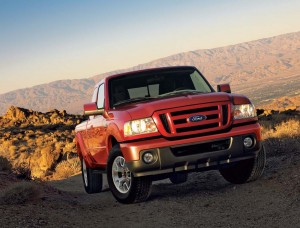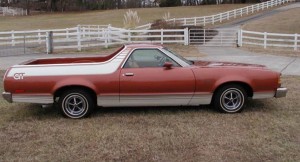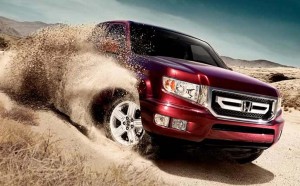When Ford announced it would finally pull the plug on the long-lived Ranger compact pickup a few years back, many expected the maker would simply replace it with the all-new Ranger model it had develop for worldwide use, launching it into production in Thailand in 2011.
Surprisingly, Ford stressed it had no intention of offering a new Ranger in the U.S. market, insisting that for the price it would have to charge for the global Ranger model buyers would all but certainly opt for the bigger F-Series, long the American market’s most popular truck. Indeed, there’s been a steady shrinkage of the compact pickup segment over the years, buyers either upsizing or abandoning trucks entirely, Ford officials insist.
So how respond to General Motors’ decision to deliver an all-new Chevrolet Colorado, never mind the ongoing presence of the Toyota Tacoma and Nissan Frontier? By shifting into an entirely new direction, Ford officials hint, that was pioneered by Honda with its distinctive Ridgeline pickup.
In other words, what some are dubbing the Ford F-100 just might adopt a crossover, or car-based, platform, a senior marketing executive reveals. That might seem a surprise considering the mixed response the Honda Ridgeline has generated.
But, “The target consumers really don’t care, as long as a car-based pickup is durable and can haul what they need. Add a reasonable sticker, and that formula will work,” Doug Scott, head of Ford Truck marketing told Car & Driver.
That’s in line with comments by Ford Chief Operating Officer Mark Fields, who recently told TheDetroitBureau.com that the Detroit maker has not completely abandoned the idea of playing in the smaller pickup segment – if it can come up with an acceptable business case.
That’s been the big problem for a Ranger replacement. Curiously, over the years, “compact” truck sales have declined as the vehicles have gotten bigger – and added more content, something known as “feature creep.” The global Ranger, said Fields, simply can’t be produced in the U.S. for a price low enough to keep most buyers from just jumping to the bigger, more capable F-Series.
Or so goes the theory. Not everyone agrees. Some see a potentially lucrative opportunity if just the right package can be produced.
“Historically, if you go back to the ’80s, the compact or midsize pickup segment was bigger than the full-size segment,” said Chrysler’s Vice President of Product Planning Joe Veltri, adding that, “Based on our data, young males still aspire to own a pickup.”
In most instances, going to a car-based design is more expensive than the classic body-on-frame approach of a truck, but Ford appears to be thinking it may be able to tone down the classic capabilities, perhaps to 1,000 pounds of cargo and 3,000 pounds of towing capacity, and build in just enough features to keep those young males happy. Slick infotainment systems go a long way these days in appealing to Millennials.
Chrysler, it appears, is looking to take a similar approach, turning its Italian partner’s Fiat Strada into a modern version of the El Camino that would be marketed through the Ram brand.
Whether Ford might go for that distinctive design – reviving its own car/truck model, the Ranchero – is yet to be seen. The other options are to make a new compact look like a baby F-Series, an F-100 perhaps, or find something in-between, along the lines of the quirky Honda Ridgeline.
Pricing will be a critical factor. There are likely some buyers who would be willing to downsize even if the price came close to the current F-Series’ $24,000 base, especially if it meant a more fuel-efficient and maneuverable offering. But Ford appears to believe it can only sell a compact in real volume by dropping the price substantially.
“The challenge,” Scott told Car & Driver, is “making a business case out of it that makes sense. We’re still working on it.”




The Ridgeline was far from a hit or great idea. I don’t see it being a success for Ford either. While a small pickup is a convenience for many people, it’s a tough sell compared to an SUV with all the whisles and bells for about the same money.
This is why Ford is far from convinced that it does not to replace Ranger. If it does it will need a real winner.
Paul E.
I purchased my F-150 new in Dec 1988. It had 7 miles on it. Reg cab, 8’box. Great for someone just needing a light-weight pickup.
Who is selling a replacement for my daily driver?
The current crop of full-size trucks is still hard to beat if you need the hauling and towing capacity.
Paul E.
Here is a novel idea…Bring back the Ranger! They now make and sell the Ranger overseas with a clean diesel motor, as well as a 4 cylinder motor. I have owned two Rangers, a 1993 and a 2000. My 2000 Ranger has 175,000 miles and has had no problems. I can carry almost anything I need. No, it cannot tow a space shuttle and No, it cannot haul another truck (Think of the new Toyota and the old GMC commercials) That being said, it does as good as any other truck for what I need. Where Ford failed the Ranger, was that while they upgraded the fuel economy of the F-Series trucks, they did nothing for the Ranger’s fuel economy. They also did no serious changes from 2000 – 2011 other than putting the silly large blue oval on the tail gate. If they had given some fuel mileage upgrades and a few minor cosmetic changes, the Rangers would still be selling. Ford also overpriced the Rangers which did themselves no favors. New F-150 = $20,000 basic. New 2011 Ranger = $20,000 basic. See the problem??? FORD – Hello!!!
Hi, Dale,
We’ve had fairly extensive coverage of the debate over the new Ranger produced and sold outside the U.S. Ford insists that the design is simply too expensive to be produced and sold here because it would wind up with little gap between the new Ranger and the existing F-Series. As a result, its research, Ford claims, says buyers would simply opt for the bigger and more capable F-Series. I’m not taking sides here, just relaying the argument.
Paul A. Eisenstein
Publisher, TheDetroitBureau.com